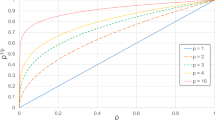Abstract
In this paper, a topology optimization model for transient thermo-elastic coupling problems is proposed. Based on the method of solid isotropic material with penalization, the coupled equations of transient thermomechanical field are established. In this model, the objective is to minimize the global structural compliance with volume and maximum temperature constraints during the working time. To efficiently restrict the maximum temperature of the transient thermo-elastic structure in time and spatial dimensions, the regional temperature control scheme is constructed using the aggregation function. The adjoint variable method is adopted to derive the sensitivity of objective function and constraints, and the design variables are updated through the method of moving asymptotes to obtain clear optimal topologies. The effects of the duration and magnitude of the thermal and structural loads on the optimization results are discussed through several numerical examples.






Similar content being viewed by others
Availability of data and material
All data generated or analyzed during this study are included in this published article.
References
Yan JY, Xiang R, Kamensky D, Tolley MT, Hwang JT. Topology optimization with automated derivative computation for multidisciplinary design problems. Struct Multidiscip Optim. 2022;65:151. https://doi.org/10.1007/s00158-022-03168-2.
Dai YJ, Ren XJ, Wang YG, Xiao Q, Tao WQ. Effect of thermal expansion on thermal contact resistance prediction based on the dual-iterative thermal–mechanical coupling method. Int J Heat Mass Transf. 2021;173:121243. https://doi.org/10.1016/j.ijheatmasstransfer.2021.121243.
Nguyen TT, Waldmann D, Bui TQ. Computational chemo-thermo-mechanical coupling phase-field model for complex fracture induced by early-age shrinkage and hydration heat in cement-based materials. Comput Methods Appl Mech Eng. 2019;348:1–21. https://doi.org/10.1016/j.cma.2019.01.012.
Guo C, Liu HL, Guo Q, Shao XD, Zhu ML. Investigations on a novel cold plate achieved by topology optimization forlithium-ion batteries. Energy. 2022;261:125097. https://doi.org/10.1016/j.energy.2022.125097.
Bendsøe MP, Kikuchi N. Generating optimal topologies in structural design using a homogenization method. Comput Methods Appl Mech Eng. 1988;71(2):197–224. https://doi.org/10.1016/0045-7825(88)90086-2.
Bendsøe MP. Optimal shape design as a material distribution problem. Struct Multidiscipl Optim. 1989;1(4):193–202.
Zhou M, Rozvany GIN. The COC algorithm, part II: topological, geometrical and generalized shape optimization. Comput Methods Appl Mech Eng. 1991;89(1–3):309–36. https://doi.org/10.1016/0045-7825(91)90046-9.
Xie YM, Steven GP. A simple evolutionary procedure for structural optimization. Comput Struct. 1993;49(5):885–96. https://doi.org/10.1016/0045-7949(93)90035-C.
Huang X, Xie YM. Bi-directional evolutionary topology optimization of continuum structures with one or multiple materials. Comput Mech. 2009;43(3):393–401. https://doi.org/10.1007/s00466-008-0312-0.
Wang MY, Wang X, Guo D. A level set method for structural topology optimization. Comput Methods Appl Mech Eng. 2003;192(1):227–46. https://doi.org/10.1016/S0045-7825(02)00559-5.
Guo X, Zhang WS, Zhong WL. Doing topology optimization explicitly and geometrically—A new moving morphable components based framework. J Appl Mech. 2014;81:081009. https://doi.org/10.1115/1.4027609.
Zhang WS, Chen JS, Zhu XF, Zhou JH, Xue DC, Lei X, Guo X. Explicit three dimensional topology optimization via moving morphable void (MMV) approach. Comput Method Appl Mech Eng. 2017;322:590–614. https://doi.org/10.1016/j.cma.2017.05.002.
Rodrigues H, Fernandes P. A material based model for topology optimization of thermoelastic structures. Int J Numer Methods Eng. 1995;38(12):1951–65. https://doi.org/10.1002/nme.1620381202.
Sigmund O, Torquato S. Design of materials with extreme thermal expansion using a three-phase topology optimization method. J Mech Phys Solids. 1997;45:1037–67. https://doi.org/10.1016/S0022-5096(96)00114-7.
Yan J, Guo X, Cheng G. Multi-scale concurrent material and structural design under mechanical and thermal loads. Comput Mech. 2016;57:437–46. https://doi.org/10.1007/s00466-015-1255-x.
Yuan BS, Ye HL, Li JC, Wei N, Sui YK. Topology optimization of geometrically nonlinear structures under thermal-mechanical coupling. Acta Mech Sin. 2022. https://doi.org/10.1007/s10338-022-00342-3.
Gao T, Zhang WH. Topology optimization involving thermo-elastic stress loads. Struct Multidiscip Optim. 2010;42:725–38. https://doi.org/10.1007/s00158-010-0527-5.
Deng SG, Suresh K. Stress constrained thermo-elastic topology optimization with varying temperature fields via augmented topological sensitivity based level-set. Struct Multidiscip Optim. 2017;56:1413–27. https://doi.org/10.1007/s00158-017-1732-2.
Zhu XF, Zhao C, Wang X, Zhou Y, Hu P, Ma ZD. Temperature-constrained topology optimiz-ation of thermo-mechanical coupled problems. Eng Optimiz. 2019;51:1687–709. https://doi.org/10.1080/0305215X.2018.1554065.
Meng QX, Xu B, Wang C, Zhao L. Thermo-elastic topology optimization with stress and tem-perature constraints. Int J Numer Methods Eng. 2021;122:2919–44. https://doi.org/10.1002/nme.6646.
Turteltaub S. Optimal material properties for transient problems. Struct Multidiscip Optim. 2001;22:157–66. https://doi.org/10.1007/s001580100133.
Zhuang CG, Xiong ZH. A global heat compliance measure based topology optimization for the transient heat conduction problem. Num Heat Trans Part B Fund. 2014;65:445–71. https://doi.org/10.1080/10407790.2013.873309.
Zhuang CG, Xiong ZH. Temperature-constrained topology optimization of transient heat conduction problems. Num Heat Trans Part B Fund. 2015;68:366–85. https://doi.org/10.1080/10407790.2015.1033306.
Wu SH, Zhang YC, Liu ST. Topology optimization for minimizing the maximum temperature of transient heat conduction structure. Struct Multidiscip Optim. 2019;64:1385–99. https://doi.org/10.1007/s00158-019-02196-9.
Zhao QH, Zhang HX, Wang FJ, Zhang TZ, Li XQ. Topology optimization of non-Fourier heat conduction problems considering global thermal dissipation energy minimization. Struct Multidiscip Optim. 2021;64:1385–99. https://doi.org/10.1007/s00158-021-02924-0.
Li XQ, Zhao QH, Long K, Zhang HX. Multi-material topology optimization of transient heat conduction structure with functional gradient constraint. Int Commun Heat Mass Transf. 2022;131:105845.
Hooijkamp EC, van Keulen F. Topology optimization for linear thermo-mechanical transient problems: modal reduction and adjoint sensitivities. Int J Numer Methods Eng. 2017;113(8):1230–57. https://doi.org/10.1002/nme.5635.
Ogawa S, Yamada T. Topology optimization for transient thermomechanical coupling problems. Appl Math Model. 2022;109:536–54. https://doi.org/10.1016/j.apm.2022.05.017.
Kennedy GJ, Hicken JE. Improved constraint-aggregation methods. Comput Methods Appl Mech Eng. 2015;289:332–54. https://doi.org/10.1016/j.cma.2015.02.017.
Svanberg K. The method of moving asymptotes—A new method for structural optimization. Int J Numer Methods Eng. 1987;24:359–73. https://doi.org/10.1002/nme.1620240207.
Acknowledgements
The authors are thankful for Professor Krister Svanberg who made the MMA program freely available for research purposes and the anonymous reviewers’ helpful and constructive comments.
Funding
National Natural Science Foundation of China, 52175236.
Author information
Authors and Affiliations
Corresponding author
Ethics declarations
Conflict of interest
The authors declare that they have no competing financial interests.
Consent for publication
Not applicable.
Rights and permissions
Springer Nature or its licensor (e.g. a society or other partner) holds exclusive rights to this article under a publishing agreement with the author(s) or other rightsholder(s); author self-archiving of the accepted manuscript version of this article is solely governed by the terms of such publishing agreement and applicable law.
About this article
Cite this article
Chen, J., Zhao, Q., Zhang, L. et al. Topology Optimization of Transient Thermo-elastic Structure Considering Regional Temperature Control. Acta Mech. Solida Sin. 36, 262–273 (2023). https://doi.org/10.1007/s10338-022-00377-6
Received:
Revised:
Accepted:
Published:
Issue Date:
DOI: https://doi.org/10.1007/s10338-022-00377-6




